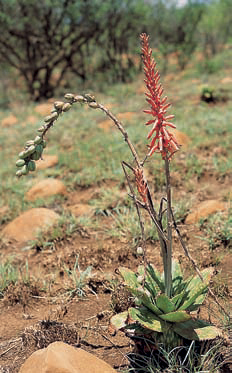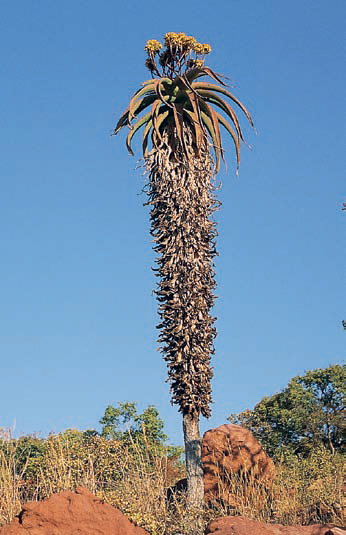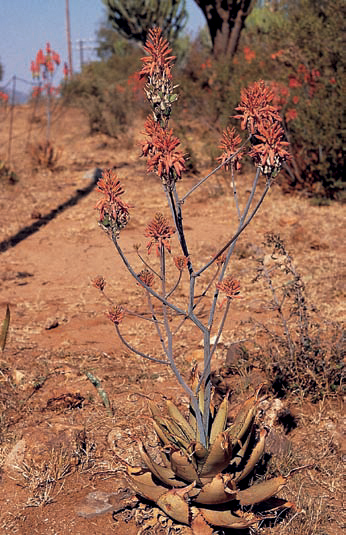

Savanna regions are characterized by distinct grass and tree layers. In the dry winter season, the African grasslands, such as here, near the border between South Africa and Zimbabwe, turn yellow as deciduous trees shed their leaves. In the last rays of the setting sun, a flowering Aloe angelica towers over the landscape where it grows naturally.


Aloe vanrooyenii (top) and A. castanea (above) are typical of the species found in the savanna region.
Savanna, locally called bushveld – a landscape of grassy veld interspersed with trees and bushes – forms the iconic landscape image of Africa. The trees are solitary or in dense or sparse clumps, and often have flat-topped canopies, as in some Acacia (thorn trees) and Albizia (false thorns) species. In bushveld, the ground layer consists of an exceedingly diverse range of grass species, nearly 800 in southern Africa alone, of all descriptions and sizes. The bushveld regions typically receive summer rain, and their climate can best be described as mild and subtropical, although the severity of rather frequent cold spells in winter should not be underestimated! The densest concentration of different species of Aloe in the world is found in savanna, particularly around the town of Burgersfort in Mpumalanga, a region known as Sekhukhuneland.

This robust spotted (maculate) aloe, one of the larger members of the group, is mostly solitary. The light to mid-green leaves are contracted into strong, short-stemmed or stemless rosettes that hardly protrude above the dense grasses among which it grows. Leaf margins are armed with sharp, brown teeth. Inflorescences are much branched, giving the plant an overgrown appearance. Flowers are mostly deep red, with the unmistakable basal swelling of spotted aloe flowers.

Plants grow as solitary unbranched specimens that can reach a height of several metres. Leaves tend to be channelled and strongly recurved. Flowers are yellow, tinged with orange, and arranged into short, densely flowered inflorescences. The species is restricted to a small area in the Soutpansberg mountain range in Limpopo Province.

Plants grow as medium-sized rosettes that hardly ever produce suckers. The leaves are brownish green and mottled throughout with white flecks. Flowers are fairly small, bright red and arranged into head-shaped clusters on a much-branched inflorescence. This typical maculate aloe can be easily distinguished from its relatives because of the white flecks that become confluent into white longitudinal stripes, and the small clusters of bright red flowers.

This dainty maculate aloe seems to be more or less restricted to the vicinity of Burgersfort in Mpumalanga. Plants are fairly small, and the white-mottled leaves tend to be a dirty khaki colour. The flowers are dull pink and hardly distinguishable among the surrounding vegetation during the drab, dry flowering season. The inflorescences are loosely flowered, but grow taller than most aloes with similar sized rosettes.

Plants usually grow as single-trunked, or very rarely, branched, specimens that carry large, strongly recurved leaves in robust rosettes. The trunks are usually covered by a skirt of dry leaves. The leaves have large, smooth surfaces and are deeply channelled. The species, often regarded as synonymous with Aloe ferox, has dull red flowers arranged into thick, erect candles. Mature specimens of A. candelabrum tend to produce more candles per inflorescence than A. ferox, and its inflorescences often appear to be ‘sunken’ into a rosette. Some of the A. candelabrum plants that have been established alongside the N3 highway between Durban and Pietermaritzburg have developed into strikingly beautiful specimens.

These take the form of stout, branched trees with strong rosettes of long, dull green leaves perched at the tips of the branches. The inflorescences are variously curved to resemble cat’s tails. The yellowish brown flowers are fairly small and tightly arranged on the inflorescences. The species was named for the chestnut brown nectar that is produced in copious amounts in the small, cup-shaped flowers. Within South Africa, it occurs in typical northern savannas.

Plants grow as medium-sized specimens that slowly sucker from the base. The leaves are borne near-vertically, upcurved and, in the dry season, incurved. Leaf colour varies from typically bluish sea-green to light green. The flowers are small, ranging in colour from red to orange, and arranged into head-shaped to elongated, much branched inflorescences. This widespread species is easy to cultivate and is an excellent choice for mass planting.

These stemless plants have robust rosettes of light to dark green, sharply tapering leaves. The leaf margins are armed with short, sharp-tipped, brown teeth. The inflorescences are shaped like inverted cones, while the individual flowers are fairly large and loosely packed on the inflorescence branches. Although it is a summer-rainfall species, it grows remarkably well in the Western Cape.

Plants grow as tall, usually unbranched, specimens that can reach several metres. The boat-shaped leaves closely resemble those of Aloe marlothii, but tend to be somewhat shorter and more gracefully recurved. Inflorescences are branched and consist of several short, vertical to outwardly bent branches. The flowers, which range in colour from red through orange to yellow, are tightly packed in the inflorescences.

Plants grow as solitary rosettes that consist of numerous erect to apically recurved leaves. Bluish green leaves carry numerous whitish teeth along their margins. The inflorescence is horizontally branched, and the reddish white, distinctly club-shaped flowers point upwards. The flower mouths are hardly open, to prevent nectar from being diluted by rain, or concentrated through exposure to high levels of irradiance. The horizontal inflorescence branches make this a very distinctive aloe.

A typical maculate aloe with medium-sized rosettes that can develop short stems. As the specific epithet ‘immaculata’ indicates, the leaves can be devoid of white, H-shaped spots commonly found on leaves of maculate aloes, while some forms of the species can have heavily mottled leaves. Leaf margins are typically armed with sharp, brown teeth. Inflorescences are usually branched, and carry pink to blood-red flowers with characteristic basal swellings in dense or loosely packed clusters.

Plants grow as solitary, stemless specimens. The leaves are erect and incurved during times of drought. The inflorescences are bi-coloured, with the open flowers yellow and the buds red. Plants tend to remain considerably smaller than those of Aloe cryptopoda (see page 88) and A. wickensii (see page 95), both of which have a similar growth form and general appearance.

This very variable species usually grows as a majestic specimen that consists of a strong rosette of densely prickled, boat-shaped leaves that are perched at the tips of robust stems. The stems are almost invariably clothed in the remains of dry leaves. The flowers are borne vertically on inflorescence branches that have horizontal side-branches.

Plants sucker from the base to give rise to small to large clumps. The leaves are either light green and spotted with white flecks, or uniformly purple. Flower colour varies from light, dusty pink to orange. The species is very easy in cultivation and will thrive in virtually any type of soil. In cultivation, leaves tend not to die back, as they do in their natural habitat.

A medium-sized, compact plant with fairly large rosettes, dense leaves and short stems. This species has one of the most striking inflorescences of all aloes, growing to several times the height of the plant, especially when young. It flowers when the plants are quite small, producing bright pinkish, almost perfectly pencil-shaped flowers. Aloe pretoriensis dislikes captivity, and transplants from nature invariably die. Even from seed, plants require a great deal of energy from the grower to keep them flourishing.


A typical spotted aloe; its long, snake-like leaves are cross-banded with densely arranged and confluent white blotches. The leaves are arranged into an open rosette precariously perched on a short stem that often bends and twists on the ground for part of its length, before turning upright to support the rosette in a perfectly erect position. The inflorescence is tall, much-branched and carries fairly dense clusters of dull pink flowers with white stripes. One of the most distinctive features is the dense layer of white powder (a waxy bloom) that covers all its above-ground parts, except the leaves. This species favours the somewhat milder environs of the eastern parts of southern KwaZulu-Natal, where it is restricted to a small area around Pietermaritzburg. It grows very fast and will flower within two to three years from seed.

Plants grow as robust, erect specimens that almost invariably remain unbranched. The leaves are large and boat-shaped, usually with teeth spread over both their upper and lower surfaces. Inflorescences are much-branched and consist of several near-erect racemes. Flowers vary from yellow to bright orange and tend to be arranged on one side of the inflorescence branches only. The species is sometimes included in Aloe marlothii.

Plants grow as medium-sized to large shrubs that consist of strong rosettes of numerous slender leaves, normally dull green but turning bright red in exposed positions. Inflorescences are densely packed with small, yellow flowers. Plants are easy to cultivate and this is one of the most common aloes of the savannas of Limpopo, Mpumalanga and northern KwaZulu-Natal.

A nondescript, but variable, maculate aloe that flowers in summer and usually carries fairly insignificant dusty-looking, reddish pink flowers. This species of spotted aloe is an enigma; in the southern parts of its distribution range it seems sufficiently different from other forms of Aloe zebrina (in which it is sometimes included) to warrant segregate status as a species, but to the north it grades into A. zebrina proper. There are other forms from remote, and sometimes not so remote, parts of its range that are also quite different. For most of these, species status has been proposed in the past, but today all of them are treated as part of a variable (polymorphic) A. zebrina.

This is a recently described species from the savannas of the KwaZulu-Natal midlands. Rosettes are usually solitary, medium-sized and quite robust. Flower colour varies from red to deep orange. Unlike all the other maculate aloes that occur in the province, this species flowers in summer. A distinguishing feature is its very large fruits, which can attain the size of golf balls. A raceme densely covered in fully developed fruit invariably bends towards the ground. (See page 83.)

Plants are trunkless or very short-stemmed and always remain solitary. The leaves are lance-shaped and armed with short, rather pungent teeth on their margins. Inflorescences are single or branched, and consist of uniformly bright yellow flowers. The main horticultural attractions of this species, which is quite easy to cultivate, are its neat rosettes and yellow flowers.